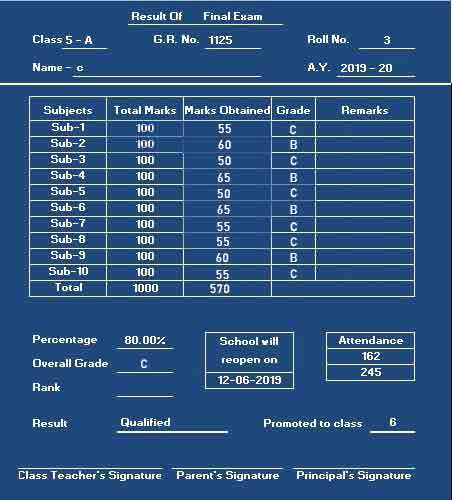
Understanding the Nigerian curriculum’s unique emphasis on continuous assessment and terminal exams is crucial. This knowledge will empower you to interpret your child’s report card accurately and make informed decisions to support their academic growth.
Report cards are simply documents issued by schools to provide feedback on a student’s academic performance over a specific period, typically a semester or academic year.
Breaking Down The Report Card
The report card typically consists of:
- Continuous Assessment (CA) includes scores from tests, assignments, and note-checking taken throughout the term.
- Exam: The score from the terminal exam held at the end of the term.
- Aggregate score: The total score is calculated from the CA and exam scores.
- Grades: Letter grades (A, B, C, D, F) or numerical grades (1-100) indicate a student’s level of mastery in each subject. A stands for excellence, B – very good, C – Credit, D – pass, and F – fail. At times, the school may employ the use of this grading system:
A – 70 to 100 Excellent
B – 60 – 69 Very good
C – 50- 59 Credit
D -40 – 49 Pass
F – 0 – 39 Fail
Interpreting The Report Card
- Identify their strengths and weaknesses by looking out for subjects or areas where your child excels or struggles.
- Analyze the Continuous Assessment scores to check the consistency of scores throughout the term. Are there areas where your child improved or declined?
- Examine the scores: Compare exam scores to CA scores. Did your child perform better or worse in the exam?
- Understand the aggregate: Calculate the aggregate score and determine if your child met the pass mark.
- Check for comments or remarks: Read teacher comments, which provide discernment into your child’s learning style, strengths, and areas for improvement.
Also Read: Four Essential Things To Do At Home To Improve Your Child’s Grades
Assessment Weightage
It’s essential to know the percentage weightage assigned to each assessment component. Inquire from the school to determine the following:
– The percentage weightage for CA (e.g., 20%, 30%, or 40%)
– The percentage weightage for the exam (e.g., 80%, 70% or 60%)
– How the aggregate score is calculated
Making Positive Changes
- Set goals: Collaborate with your child to set achievable goals for improvement in weak areas.
- Develop a study plan: Create a schedule or timetable and habits to help your child stay on track.
- Seek additional resources: Arrange for tutoring (home lessons), online resources, or extra help from teachers if needed.
- Support your child in taking ownership of their learning, asking questions, and seeking help when needed.
- Regularly check in with your child and teachers to track improvement.
- Acknowledge and celebrate small victories and improvements along the way.
- Attend parent-teacher conferences, volunteer in class, and stay informed about school activities.
- Maintain open communication with teachers and the school.
- Encourage your child to ask questions and seek help when needed.
- Foster a progressive mindset, emphasising effort and progress over grades.
- Provide a supportive and encouraging environment that promotes a love for learning.
- Stay organised and keep track of assignments, due dates, and upcoming tests.
Remember, the report card is not just a reflection of your child’s performance, but also a powerful tool for growth and improvement.
With the guidance provided, you’ll be empowered to interpret your child’s report card effectively and make informed decisions to support their academic success.
Get more parenting resources here.



